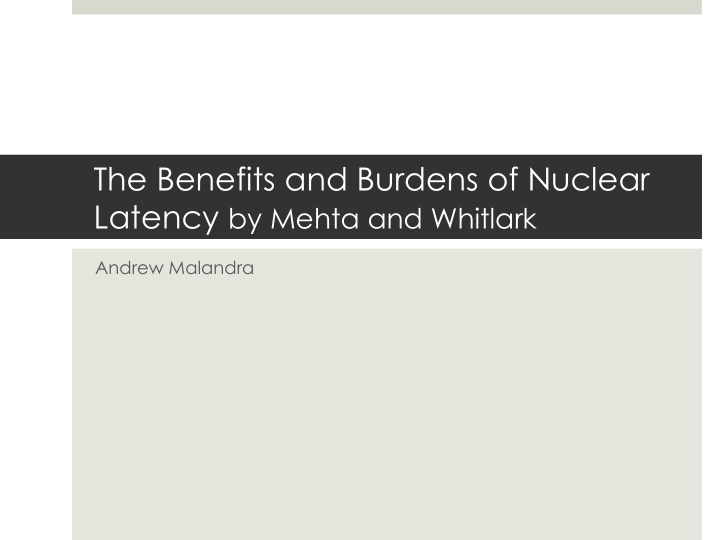



The Benefits and Burdens of Nuclear Latency by Mehta and Whitlark Andrew Malandra
Possible Effects of Latency
The Background Virtual Deterrence Latency Provocation Theory Theory ¤ You can’t deter challengers ¤ Essentially it’s the same as without an operational and having the bomb deliverable weapon ¤ Latency functions both as ¤ Latency welcomes non- a deterrent to aggression proliferation sanctions and and as leverage in preemptive attacks negotiation ¤ Both a threat to security and ¤ Hypotheses 1-5 economic prosperity ¤ Hypotheses 6 & 7
Hypotheses • States that acquire nuclear latency are less likely to be the target of militarized interstate disputes. • States that acquire nuclear latency are more likely to initiate militarized interstate disputes. • States that acquire nuclear latency are more likely to receive military assistance from the United States • States that acquire nuclear latency are more likely to receive economic assistance from the United States.
Hypotheses (Cont.) • States that acquire nuclear latency are more likely to experience success in the issuance of compellent threats against target states. • States that acquire latency are more likely to be the target of militarized interstate disputes. • States that acquire nuclear latency are more likely to be the target of US-imposed economic sanctions.
Independent Variable
Measuring Latency (ENR) ¤ Focus on enrichment and reprocessing (ENR) facilities ¤ Use an expanded dataset of ENR capabilities based on Fuhrmann and Tkach’s 2015 paper ¤ Focus on a dichotomous variable: either a state has ENR capabilities beyond a laboratory scale or a state does not
Coding Latency In order to be coded as latent in a given year a state must operate ENR facilities that are: ¤ Functional ¤ Non-laboratory-level (Pilot-scale) ¤ On their own soil Further, states must not have nuclear weapons
Table 1. States with pilot-scale ENR facilities: 1945-2012 22 states are identified as operating pilot- scale ENR facilities in the given 67 years
Dependent Variables
3 Categories -- Capturing Latency’s Effect on: 1 military and coercive bargaining power 2 political and economic outcomes 3 how states interact with potential adversaries
Category 1: military and coercive bargaining ¤ Target of a Militarized Interstate Dispute (MID) ¤ 1 if yes; 0 if not (in a given year) ¤ Initiator of a MID ¤ 1 if yes; 0 if not (in a given year ) Note: focus solely on fatal MIDs in order to “capture how nuclear latency impacts state behavior in truly threatening security environments”
Category 2: political and economic outcomes ¤ Military assistance from the United States ¤ 1 if the state received military assistance from the US; 0 if not (in a given year) ¤ Economic assistance from the United States ¤ 1 if the state received economic assistance from the US; 0 if not (in a given year) Note: variables from the US Agency for International Development (USAID )
Category 3: how states interact with potential adversaries ¤ Compellent threat success ¤ From Sechser’s Militarized Compellent Threat data ¤ 1 if a state is successful in having their demands met by a target; 0 if not (in a given year) ¤ Imposition of US sanctions ¤ From Hufbauer et al. 2007 ¤ 1 if the US imposed sanctions on a state; 0 if not (in a given year)
Control Variables
Control Variables ¤ US ally ¤ 1 if state has an operating defense pact with the US; 0 if not ¤ US Nuclear Assistance (US NCA) ¤ As defined by the Atomic Energy Act ¤ Military Capability ¤ Measured using Correlates of War’s Composite Index of National Capability (CINC) ¤ Rivalry ¤ Whether a state has lasting regional rivalries ¤ Borders ¤ Codes an ordinal measure of contiguity in order to account for a state’s regional security environment
Control Variables (cont.) ¤ Regime Type ¤ Measured using Polity IV scores ¤ Polity Change ¤ Measures a 5-year change in Polity scores ¤ GPD per capita ¤ Economic openness ¤ NPT Signatory ¤ NPT Era ¤ To account for a possible non-proliferation norm
Results
Table 2: Summary Table 2 includes a summary of the main coefficient estimates from the analyses, where controls are included but not presented. Note: Models 1-7 relate to hypotheses 1-7 respectively
Table 3: Full Regression
Table 4: US ally status’ effect on Models 3, 4 and 7 (Here 1, 2 and 3)
What does this mean for Iran (and the world)?
No Idea! Backing Down Producing an arsenal ¤ Given the findings that ¤ Given the likelihood of latency is both correlated sanctions for continued with aggressive behavior efforts to bolster the state’s and unsatisfactory in nuclear capacity it may be deterrence a mix of that Iran will not pursue regional tensions enflamed further nuclear by Iranian aggression and development and be an inability to protect itself content to maintain their from retaliation to that latency aggression with a latent arsenal may lead Iran to Note: the article does say the pursuit of develop nuclear weapons latency may be shown to be halted by the evident costs and further research should focus on why states pursue latency
Questions
Recommend
More recommend